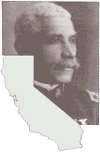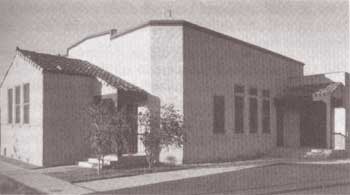![]()

Five Views: An Ethnic Historic Site Survey for California
MENU
Introduction
A.M.E. Church
Education
Industry
Farming
Business
Associations
Noted Individuals
Historic Sites
Selected References

A History of Black Americans in California:
HISTORIC SITES
Douglass High School
El Centro, Imperial County
Douglass High School is a one-story stucco structure, moved in 1959 to its present location. It has recently been restored, and both the building and site are in excellent condition.
California's Black population increased in the first decades of the twentieth century, as did discrimination against people of color. Discrimination was especially intense where public accommodations, employment, education, and housing were concerned. A pattern consistent with the nation's policies on institutional racism emerged in Imperial County with introduction of non-White laborers recruited into the valley from the southern United States and Mexico to build the embryonic cotton industry.
The El Centro Elementary School District instituted formal school segregation with the 1913-1914 school year, an act precipitated by the first wave of Black labor immigration. In 1913, when Black parents first applied for admission of their children to the El Centro Elementary School District, the superintendent created a separate school, allegedly because of overcrowding at the existing sites. Black parents therefore registered early the following year only to have their children again assigned to the separate school. Intent on abolishing this new system of segregation, Black parents immediately organized the El Centro Parents Association and retained a Los Angeles attorney to represent them.
Segregation, however, was not soon abolished; instead, it became institutionalized and continued for nearly a half century. In 1923, for example, Professor William Payne, principal of the all-Black Dunbar Elementary School, went to El Centro High School to register his eldest daughter, Octavia. Admission was denied. A high school education was simply unavailable to Blacks in this valley town. Ultimately, on August 20, 1925, the High School District voted to pay the El Centro City School District $1,831.16 for use of buildings and grounds on the Eastside Elementary School site. The lease was to run for 20 years, beginning March 1, 1926. The arrangement allowed Professor Payne, the school's principal, who held both high school and junior college teaching credentials, to extend instruction through the twelfth grade. This policy lasted one year. In 1927, the Central Union High School District Board voted to organize a separate secondary school.
On December 11, 1929, the Central Union High School District approved a $15,334.69 expenditure for architectural plans, construction, and outfitting of a high school building for Black secondary students. Located in the segregated Eastside, the Black neighborhood, the new school was fittingly called Eastside High School. A few years later, Eastside residents successfully petitioned the Board of Trustees to rename the school Douglass High School. On September 9, 1936, the Board granted the request. Fifteen years elapsed before authorization was finally given to change the inscription on the building.
Douglass High School, under Professor William Payne's principalship, offered both high school and junior college curricula. However, the school could not officially grant either degree. Central Union High School issued high school diplomas, and Imperial Valley Junior College conveyed the Associate of Arts degrees.
Instructors at both the elementary and high school were remembered as being extraordinary teachers. Many talented young Black teachers applied to the district, since it was one of the few systems where a Black teacher could secure a regular teaching appointment. Common practice among districts throughout the state was to require Black teachers to have at least one year of experience as a regular teacher in a California district before a permanent appointment could be considered. This requisite experience could be gained in few places outside the Imperial Valley. El Centro's segregated district ironically aided a few teachers who penetrated the color barrier after teaching for one year or more at either Dunbar or Douglass school.
Douglass High School was closed in 1954, following the Supreme Court's Brown v. Board of Education school desegregation decision. After the school's closing, the trustees sold the building to the El Centro School District because at the time, the elementary district's needs warranted the purchase. Soon, however, it was once again a surplus building, and the El Centro School District voted to sell the structure and have it removed from the site by August 1, 1958. The Mason's Eureka Lodge #28, El Centro, bid $1,000 for purchase of the Douglass Auditorium. The Masons placed the highest bid and subsequently received title to the building. Restoration of the building's exterior has been completed while the interior has been maintained but not rehabilitated. It is well preserved, and now serves as the Masonic Hall in El Centro.

Douglass High School, El Centro, Imperial County
NEXT> Fifty-first Street School
Last Modified: Wed, Nov 17 2004 10:00:00 pm PDT
http://www.cr.nps.gov/history/online_books/5views/5views2h38.htm
![]()
 Top
Top